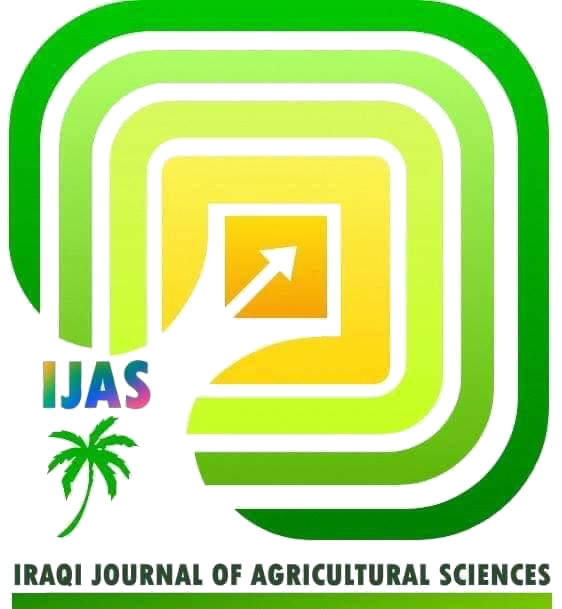THE EFFECT OF IRRIGATION INTERVAL AND SOME ENVIRONMENTAL SUSTAINABILITY FACTORS ON GROWTH AND PRODUCTION OF COWPEA PLANTS
DOI:
https://doi.org/10.36103/a22jw446Keywords:
zeolite, kaolin, electrolyte leakage, DPPH.Abstract
This study was conducted during the spring season of 2023-2024 and the fall season of 2024-2025 at the fields of the College of Agricultural Engineering Sciences, University of Baghdad, to investigate effects of irrigation intervals I1 ,I2 (3 and 6 days) , soil amendment with zeolite at three concentrations Z0 ,Z1,Z2 (0, 4, and 8 g. kg soil⁻¹), and foliar spraying with kaolin for three concentrations C0,C1,C2 (0, 0.5, and 1 g .L⁻¹). The results revealed that the treatment I1Z2C2 significantly excelled in leaf area, chlorophyll concentrations, and yield for both seasons, achieving 31.0 dm², 21.5 mg per 100 g fresh weight, and 1984.7 g in the first season, and 34.08 dm², 23.6 mg per 100 g fresh weight, and 2526.3 g in the second season. In contrast, the treatment I2Z0C0 significantly outperformed others in proline concentration, peroxidase enzyme activity, and antioxidant capacity (DPPH), recording 45.5 mg g⁻¹ dry weight, 1.09 absorption units g⁻¹ protein, and 73.3% in the first season, and 101.80 mg g⁻¹ dry weight, 4.400 absorption units g⁻¹ protein, and 92.0% in the second season.
References
1. Adekalu, K. O., and D. A. Okunade, 2008. Evaluation of crop yield models for cowpea in Nigeria. Irrigation Science, 26(5), 385-393. https://doi.org/10.1007/s00271-008-0103-6
2. Abdel-Hassan, S.N., and A.M. Radi, 2018. Effect of zeolite on some physical properties of wheat plant growth (Triticum aestivum L.). Plant Archives, 18, 2641-2648.
https:/doi/api.semanticscholar.org/CorpusID:217068531
3. Abed, N. Y., and H. K. S. Al-Essawi. 2024. Evaluation of oat varieties under sufficient and insufficient irrigation. Iraqi Journal of Agricultural Sciences 55 (3): 1251–1258. https://doi.org/10.36103/j5f16091
4. Adekalu, K. O., and D. A. Okunade, 2006. Effect of irrigation amount and tillage system on yield and water use efficiency of cowpea. Communications in soil science and plant analysis, 37(1-2), 225-237. https://doi.org/10.1080/00103620500403465
5. Al-Hlfie, Rawaa G., and Wafaa A. Hussein. 2024. Effect of organic fertilizers and nutrients on anatomical traits of red beetroots. Iraqi Journal of Agricultural Sciences 55 (Special): 151–161. https://doi.org/10.36103/ijas.v55iSpecial.1894.
6. Al-Jamal, M. S., T. W. Sammis, J. G. Mexal, G. A. Picchioni, and W. H. Zachritz, 2002. A growth-irrigation scheduling model for wastewater use in forest production. Agricultural water management, 56(1), 57-79. https://doi.org/10.1016/S0378-3774(02)00003-3
7. Artyszak, A. 2018. Effect of silicon fertilization on crop yield quantity and quality—A literature review in Europe. Plants, 7(3), 54. https://doi.org/10.3390/plants7030054
8. Akbari, H., S. A. M. Modarres-Sanavy, and A. Heidarzadeh, 2021. Fertilizer systems deployment and zeolite application on nutrients status and nitrogen use efficiency. Journal of Plant Nutrition, 44(2), 196-212. https://doi.org/10.1080/01904167.2020.1806299
9. Al-Mokadem, A. Z., M. H. Sheta, A. G. Mancy, H.-A. A. Hussein, S. K. M. Kenawy, A. R. Sofy, M. S. Abu-Shahba, H. M. Mahdy, M. R. Sofy, A. F. Al Bakry, and S. Mona Agha. 2023. Synergistic effects of kaolin and silicon nanoparticles for ameliorating deficit irrigation stress in maize plants by upregulating antioxidant defense systems. Plants 12: 2221. https://doi.org/10.3390/plants12112221.
10.Abdel-Galil, F. A., M. A. M. Amro, and A. S. H. Abdel-Moniem, 2007. Effect of drought stress on the incidence of certain arthropod pests and predators inhabiting cowpea plantations. Archives of Phytopathology and Plant Protection, 40(3), 207-214. https://doi.org/10.1080/03235400500424570
11. Aquino, J. P. A. D., A. A. D. C. Bezerra, F. D. ALCÂNTARA, C. J. G. D. S. LIMA, and R. R. D. Sousa, 2017. Morphophysiological responses of cowpea genotypes to irrigation water salinity. Revista Caatinga, 30(4), 1001-1008.
https://doi.org/10.1590/1983-21252017v30n421rc
12. Blattner, C. 2020. Just transition for agriculture? a critical step in tackling climate change. Journal of Agriculture, Food Systems, and Community Development 9: 1–6. https://doi.org/10.5304/jafscd.2020.093.006
13. Chu, C. C., T. J., Henneberry, and J. W. Radin. 1995. Effect of irrigation frequency on cotton yield in short‐season production systems. Crop science, 35(4), 1069-1073. https://doi.org/10.2135/cropsci1995.0011183X003500040025x
14. He, C. W., J. Ma, and L. J. Wang. 2015. A hemicellulose-bound form of silicon with potential to improve the mechanical properties and regeneration of the cell wall of rice. New Phytologist 206: 1051–1062. https://doi.org/10.1186/s42269-022-00934-6.
15. Kanda, E. K., A. Senzanje, T. Mabhaudhi, and S. C. Mubanga, 2020. Nutritional yield and nutritional water productivity of cowpea (Vigna unguiculata L. Walp) under varying irrigation water regimes. Water SA, 46(3), 410-418.
16. Mbagwu, J. S. C., and J. O. Osuigwe, 1985. Effects of varying levels and frequencies of irrigation on growth, yield, nutrient uptake and water use efficiency of maize and cowpeas on a sandy loam ultisol. Plant and soil, 84(2), 181-192. https://doi.org/10.1007/BF02143182
17. Onofiok, O. E. 1989. Effect of soil compaction and irrigation interval on the growth and yield of cowpea on a Nigerian Ultisol. Soil and Tillage Research, 13(1), 47-55.
https://doi.org/10.1016/0167-1987(89)90037-8
18. Seelig, H. D., R. J. Stoner, and J. C. Linden, 2012. Irrigation control of cowpea plants using the measurement of leaf thickness under greenhouse conditions. Irrigation Science, 30(4), 247-257. https://doi.org/10.1007/s00271-011-0268-2
19. Turk, K. J., and A. E. Hall, 1980. Drought adaptation of cowpea. IV. Influence of drought on water use, and relations with growth and seed yield 1. Agronomy Journal, 72(3), 434-439. https://doi.org/10.2134/agronj1980.00021962007200030007x
20. Tyem, M. N., and S. T. Chieng, 1985. Irrigation scheduling effects on yield and phosphorus uptake of cowpea. Agricultural water management, 10(4), 343-355. https://doi.org/10.1016/0378-3774(85)90023-X
21. Tavares, D. S., T. E. K. Fernandes, Y. L. Rita, D. C. Rocha, B. F. Sant’Anna-Santos, and M. P. Gomes. 2021. Germinative metabolism and seedling growth of cowpea (Vigna unguiculata) under salt and osmotic stress. South African Journal of Botany 139: 399–408.
https://doi.org/10.1016/j.sajb.2021.03.019
22. Torma, S., J. Vilcek, P. Adamisin, E. Huttmanova, and O. Hronec. 2014. Influence of natural zeolite on nitrogen dynamics in soil. Turkish Journal of Agriculture and Forestry 38: 739–744.
23. Wasan, S. M. K., and Ayad W. A. Al-Juboori. 2023. Effect of biofertilizers and spraying with magnesium and calcium on vegetative growth indicators of sweet corn. IOP Conference Series: Earth and Environmental Science 1225: 012031.
24. Ziska, L. H., A. E. Hall, and R. M. Hoover, 1985. Irrigation management methods for reducing water use of cowpea (Vigna unguiculata [L.] Walp.) and lima bean (Phaseolus lunatus L.) while maintaining seed yield at maximum levels. Irrigation Science, 6(4), 223-239. https://doi.org/10.1007/BF00262468
25. Ziska, L. H., and A. E. Hall, 1983. Soil and plant measurements for determining when to irrigate cowpeas (Vigna unguiculata [L.] Walp.) grown under planned-water-deficits. Irrigation Science, 3(4), 247-257. https://doi.org/10.1007/BF00272840
26. Zheng, J., T. Chen, D. Chi, G. Xia, Q. Wu, G. Liu, and K. H. Siddique, 201). Influence of zeolite and phosphorus applications on water use, P uptake and yield in rice under different irrigation managements. Agronomy, 9(9), 537. https://doi.org/10.3390/agronomy9090537
27. Zheng, J., T. Chen, Q. Wu, J. Yu, W. Chen, Y. Chen, and G. Xia, 2018. Effect of zeolite application on phenology, grain yield and grain quality in rice under water stress. Agricultural Water Management, 206, 241-251. https://doi.org/10.1016/j.agwat.2018.05.008
28. Zheng, J., X. Luo, R. Wang, H. Yu, G. Xia, A. Elbeltagi, and D. Chi, 2024. Zeolite application coupled with film mulched drip irrigation enhances crop yield with less N2O emissions in peanut field. Soil and Tillage Research, 241, 106130. https://doi.org/10.1016/j.still.2024.106130
29. Zhao, Q., T. Chen, S. Wang, Y. Sha, F. Zhang, Y., Sun, and D. Chi, 2023. Effects of five-year field aged zeolite on grain yield and reactive gaseous N losses in alternate wetting and drying paddy system. Science of the Total Environment, 904, 166279. https://doi.org/10.1016/j.scitotenv.2023.166279
30. Zareian, F., M. Jafari, S. A. Javadi, and A. Tavili, 2018. Application of zeolite and geohumus superabsorbent on establishment and some growth indices of Nitraria schoberi L. Acta Ecologica Sinica, 38(4), 296-301. https://doi.org/10.1016/j.chnaes.2017.12.005
Downloads
Published
Issue
Section
License
Copyright (c) 2025 IRAQI JOURNAL OF AGRICULTURAL SCIENCES

This work is licensed under a Creative Commons Attribution-NonCommercial 4.0 International License.

2.jpg)


